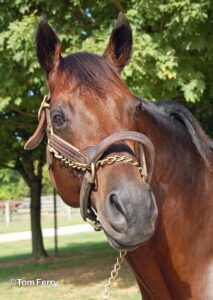In a typical year, 1,600 Pennsylvania-breds compete on the racetrack for average earnings of $27,600. Of the 50,000+ who have raced across the globe since 1985, only an elite group of 31 horses have broken the seven-figure mark in earnings. Over the course of summer 2020, the Pennsylvania Horse Racing Association will be chronicling a ten-part series featuring the select group of Pennsylvania-breds who reached the unique and rare accomplishment of $1,000,000 in racetrack earnings. Join us to celebrate and remember some of the greatest racehorses the Keystone State has produced.
Real Solution: The Ten Furlong Specialist
The Ramsey Farm of Ken and Sarah Ramsey has quickly become a staple in American thoroughbred racing. The white and red silks have become a frequent sight at racetracks across the United States for the past quarter-century. Since purchasing land in Nicholasville, Kentucky in 1994, the Ramseys have gone on to become the all-time leading owners at Churchill Downs and Keeneland, four-time champion owners, and two-time champion breeders.
For all of the accolades they’ve since received, it all started with one horse. Sarah Ramsey purchased her first thoroughbred at the 1993 Ocala March Two-Year-Old Sale, offering up $41,000 for a filly by French Group 1 winner Lear Fan. With Ken’s nickname for his wife being “Kitten”, Sarah’s first thoroughbred was appropriately named Kitten’s First.
Kitten’s First won on debut against males at Belmont Park before stepping up into stakes company in the Junior Champion at Monmouth. Sent off the favorite, she struck the gate at the start and fractured a hip. In the blink of an eye, Kitten’s First’s racing career was over. The following year, the Ramseys purchased historic Almahurst Farm and began their breeding operation with Kitten’s First.
To say Kitten’s First was the foundation of a racing empire was an understatement. While she produced a handful of nice horses, her fourth foal was where she made her mark. In 2001, she foaled a chestnut colt with a white blaze by El Prado. He was named Kitten’s Joy.
After twice racing on dirt, Kitten’s Joy was switched to grass. Over the final twelve starts of his career, he won nine times and finished second on the other three occasions. As a three-year-old, he notched six graded stakes, two of which were Grade 1, before falling short to longshot Better Talk Now in the Breeders’ Cup Turf. His accomplishments were still enough for him to be chosen as 2004 Champion Male Turf Horse. No three-year-old has won the award since.
Ken Ramsey began shopping for a stud deal for his champion, but he was quickly confronted with the realities of the American racing industry. In the dirt-dominated, speed-oriented world of North American racing, Kitten’s Joy, a long-winded turf horse, was far from conventional. So Mr. Ramsey took it upon himself and stood Kitten’s Joy for stud at Ramsey Farm.
Kitten’s First developed laminitis and soon foundered, and she was euthanized at fifteen-years-old in the same year Kitten’s Joy entered stud. The Ramseys began buying broodmares en masse to support their newest stallion. Taking the advice of fellow owner-breeder Brereton Jones, the Ramseys stamped their stallion’s offspring by incorporating “Kitten” into their names as often as they could. And in an industry where Kitten’s Joy was set up to fail, he did the exact opposite.
From their one foundation broodmare and her one son, the Ramsey’s racing and breeding empire was complete. Kitten’s Joy proved all doubters wrong by becoming a two-time champion sire in the United States. He’s led the turf sire list on six occasions (and counting), and to date has produced fourteen G1 winners, thirteen millionaires, and four champions.
With a broodmare band over 100 strong, the Ramseys sent small groups of mares to foal out in regional markets. Diamond B Farm in Mohrsville, Pennsylvania was one of them. In 2008, the Pulpit broodmare Reachfortheheavens was sent to Diamond B to foal out her first baby, and the colt by Kitten’s Joy arrived in the world on January 17, 2009.
In a rare exception, the colt was named without the traditional “Kitten” moniker and was christened Real Solution. The Ramseys decided to campaign Real Solution in Europe, although not in the country most people would expect.
On November 8, 2011, Real Solution debuted at Capannelle Racecourse in Rome, Italy, drawing away to an easy 2 ¼ length score. Under the care of trainer Gianluca Bietolini, Real Solution returned at age three to win a conditions race by seven lengths. With the Italian Derby in mind, the colt made his stakes debut in the Premio Botticelli, winning the 10.5 furlong event by five comfortable lengths. Real Solution was assumed to be a lock in the Group 2 Italian Derby and was sent off at odds of 2-5, but his unbeaten streak came to an end when he struggled to close in over the soft turf.
After finishing second in another conditions race in Italy, the decision was made to return Real Solution to the United States for his four-year-old campaign. He was transferred to top trainer Chad Brown and made his American debut in May of 2013, finishing a closely beaten fourth in the G3 Fort Marcy.
Making his Grade 1 debut next out in the Manhattan Handicap, Real Solution finished third while beaten only 1 ¾ lengths by five-time G1 winner Point of Entry. The promising performance warranted another shot at the highest level, and Real Solution shipped west to Chicago for the G1 Arlington Million. Known for attracting international participants, the 2013 Arlington Million attracted a field of thirteen, including six horses from overseas. The South African-bred The Apache was adding another continent to his globetrotting season, having already run in Dubai and England for his first year outside of South Africa.
The Apache and Real Solution broke from the gate as the fourth and fifth betting choices in the field of thirteen, and both of them settled around midpack. The Apache got first run, bulling his way towards the front of the pack to put himself within contention as the field approached the top of the stretch. Real Solution was sitting three lengths behind while looking for running room, and he exploded at the first chance for clear sailing. The Apache had taken the lead from defending champion Little Mike at the 3/16th pole, but he barely had time to open up daylight before Real Solution catapulted alongside. Just as it appeared Real Solution would fly past his rival, The Apache miraculously managed to keep his head in front for the final half furlong before crossing the wire with the advantage.
As the horses began galloping back, an objection lit up the toteboard. Alan Garcia aboard Real Solution had lodged a claim of foul against The Apache. The head-on view told the story. While initially starting down on the rail, The Apache began to drift out badly, bumping with Real Solution once, twice, three times all the while carrying him out towards the center of the racetrack. Five minutes later, the verdict was in. The Apache was disqualified, and Real Solution was made the official winner of the Arlington Million.
Real Solution followed up his first Grade 1 success with a third place effort in the G1 Joe Hirsch Turf Classic, beaten a length by Little Mike and stablemate Big Blue Kitten. He took a crack at that year’s Breeders’ Cup Turf but failed to make an impression, finishing five lengths behind Magician.
Returning at age five, Real Solution opened his year with a fourth place finish in G2 company. He stepped back up to the G1 level in the Man o’ War at Belmont Park, closing from last place but failing to catch the frontrunning Imagining by ¾ of a length. Real Solution next tackled the Grade 1 Manhattan Stakes, a race run at the same 10 furlong distance as the Arlington Million.
The 5-1 fourth choice in the field of ten, Real Solution took up his usual midpack position as frontrunning Five Iron opened up a massive lead. As the rest of the field began to shave away at Five Iron’s lead, Real Solution sat poised in fourth place while widest of all. He had dead aim on his foes as they banked into the stretch, grinding his way past Five Iron, Kaigun, and Seek Again to inch 1 ¼ lengths clear at the wire and notch his second victory in a million dollar G1 event.
The Manhattan would end up being the final victory of Real Solution’s career. After failing to defend his title in the Arlington Million, he was retired following a poor effort in the Joe Hirsch Turf Classic on September 27, 2014. From his four years on the track, Real Solution ran fifteen times with five wins, two seconds, and two thirds for lifetime earnings of $1,374,175. He won three stakes races, including two Grade 1’s worth $1 million apiece, and placed in three others. He was named PA-bred Champion Older Male and Champion Turf Horse in 2014.
Real Solution was initially retired to stand alongside his sire at Ramsey Farm in 2015. The Ramseys began to consolidate their stock the following year, and Real Solution was moved to Calumet Farm. After a two-year lease at Blue Star Racing in Louisiana, Real Solution returned to Calumet Farm in 2020 to stand for a stud fee of $7,500. His top progeny to date include two-time Canadian stakes winner Sister Peacock, Saratoga stakes winner Catch a Bid, and the stakes-placed Speedy Solution and Queens Embrace.
Lil E. Tee: The First to Wear the Roses
When Eileen’s Moment delivered her third foal on March 29, 1989, breeder Larry Littman thought the resulting colt was so ugly that he named him after an alien.
Larry Littman was a native of North Philly and frequently ran horses at Philadelphia Park. He had since moved to Palm Beach Gardens, Florida, and began breeding horses in that state before purchasing his own farm close to home in Pennington, New Jersey. Around this time, Littman had claimed the For The Moment filly Eileen’s Moment for $20,000 in Florida, and she rewarded him with a stellar record of six off-the-board efforts in six starts for earnings of $570.
After breeding Eileen’s Moment to Florida stallions for her first two foals, Littman bred her to At the Threshold and attempted to sell her in foal at the OBS Winter Mixed Sale. She hammered at $18,500 but failed to meet the reserve, so Littman opted for a change of scenery and sent the mare to Pin Oak Lane Farm in New Freedom, Pennsylvania.
The colt arrived on March 29th in all of his ugly, gangly splendor. He was so prone to colic that he lost a large portion of his intestine after a severe bout. Between the colt’s appearance and his ability to get lost at pasture, Larry Littman decided to name him after E. T., the alien from the Steven Speilberg movie. Naming all of his horses with his initials of “L I L”, Eileen’s Moment’s colt was given the peculiarly unique name Lil E. Tee.
Moving down to Florida as a yearling, and after his emergency stomach surgery, Littman decided to sell the colt to his blacksmith for a whopping $2,000. The blacksmith kept him until he was a two-year-old, entering him in the 1991 OBS April Two-Year-Olds in Training Sale. He thought he struck gold when Lil E. Tee sold for $25,000 to Al Jevremovic.
Remaining in Florida, Lil E. Tee debuted at Calder Race Course five months later, finishing a respectable second. The winner, Ima Big Leaguer, stopped the clock in a quick 1:11.56 for six furlongs and began to draw attention from horsemen around the country. One such horseman was trainer Lynn Whiting, who sent the chart to Cal Partee, one of his main clients.
But unlike everyone else, Partee wasn’t interested in Ima Big Leaguer. He noticed the colt who finished behind him in second because he was sired by Partee’s stallion At the Threshold. Partee still owned a 100% interest in the stallion, who had campaigned for him and Whiting during his racing career. At the Threshold was responsible for Whiting’s first graded stakes winner as a trainer when he won the Grade 3 Jim Beam Stakes in 1984, and he proceeded to finish third in that year’s Kentucky Derby. At the Threshold would go on to win the G2 Ohio Derby and notch a G1 winning double in the Arlington Classic and American Derby before retiring to stud for Partee.
On October 6, 1991, eight days after his debut, Lil E. Tee returned to the races and romped to an 11 ½ length maiden victory at Calder. Not long after, the $200,000 private sale was struck, and Lil E. Tee was on his way to the Churchill Downs barn of Lynn Whiting.
After carefully treating the colt for some problematic shins, Lil E. Tee made his debut for Whiting and Partee on the eve of the Breeders’ Cup, finishing a tough-luck second by a neck in an allowance event. The following day, Churchill Downs hosted the Breeders’ Cup World Championships, and the racing world was floored by a jaw-dropping performance from a juvenile colt named Arazi.
Arazi was bred in the United States but campaigned exclusively in France before his Breeders’ Cup foray. In his native country, he reeled off six consecutive stakes victories, including three straight Group 1 events, prior to returning to his home country for his first try on dirt in the Breeders’ Cup Juvenile. His dominance in France was enough for him to go off a slight 2-1 favorite in the Juvenile, but no one could have expected the show Arazi was bound to put on. Breaking from the far outside post 14 and settling in second last early on, Arazi unleashed a mind-numbing turn of foot that saw him go from thirteenth to first in a quarter of a mile, blowing past the entire field under a hand ride to win by a geared-down five lengths.
He was named Champion Two-Year-Old Colt off of that single performance, and Arazi Fever had officially taken hold.
Ten days later, Lil E. Tee was back in the starting gate, taking a Churchill allowance race by three easy lengths. But no one really noticed.
Whiting brought Lil E. Tee down south for the winter, taking up residence at Oaklawn Park in Arkansas. The colt started his three-year-old season in a February allowance race, winning by 4 ½ lengths with ease. Whiting decided Lil E. Tee was ready to take the step up to the stakes level, and penciled in the Southwest Stakes the following month. Lil E. Tee went off the second choice behind the highly regarded Pine Bluff in the Southwest, but no one was catching frontrunning longshot Big Sur. Big Sur rolled to a 2 ½ length victory at 17-1, while Lil E. Tee closed late to just miss second place, finishing in a losing photo with Pine Bluff.

Tom Ferry photo
Lil E. Tee’s Southwest performance was promising enough to forge along the Derby Trail, so Whiting decided to ship his colt north for the G2 Jim Beam Stakes at Turfway Park, the same race Lil E. Tee’s sire won prior to placing in the Kentucky Derby.
Big Sur went off the lukewarm favorite, but he got trapped in an early speed duel as Lil E. Tee traveled comfortably in midpack. Launching his bid around the far turn, Lil E. Tee catapulted from sixth to take the lead by the top of the stretch, and he maintained a length advantage over his fast-charging foes to score his first graded stakes victory.
Returning to Oaklawn for his final Kentucky Derby prep, Lil E. Tee prepared for a rematch with Pine Bluff, who had since won the G3 Rebel Stakes in his absence. The G2 Arkansas Derby only drew a field of six, but the two favorites put on a show. Lil E. Tee settled closer than normal in the early going, sitting in second place with Pine Bluff tracking directly behind him in third. When Pine Bluff made his move, Lil E. Tee went with him, and the two of them quickly opened up a four length lead on the rest of the field while approaching the top of the stretch. Pine Bluff held a narrow advantage over his rival for the duration of the stretch drive and refused to give in, finally crossing the wire by a short neck over a stubborn Lil E. Tee.
As Derby Week dawned, the racing world waited patiently for the voyage of Arazi to Louisville. Struggling with soundness issues early in the year, Arazi was forced to undergo knee surgery, and trainer Francois Boutin was in a time crunch to prepare his charge for the Kentucky Derby. Arazi recuperated soon enough to get in one prep race in France, easily winning at Saint-Cloud to bring his winning streak to eight straight. Despite his soundness problems and light preparation, the French colt was still expected to be a heavy favorite on the First Saturday in May. When he finally arrived the Sunday before the Derby, Arazi couldn’t set foot outside his barn at Churchill Downs without a flood of paparazzi parading after him. After all, he was deemed to be the second coming of Secretariat.
And still, no one really noticed Lynn Whiting’s colt.
By Derby morning, second betting choice A. P. Indy was forced to scratch with a foot bruise, and Arazi was all but considered a shoe in. Parading before the Derby Day crowd, Arazi’s odds ticked lower and lower before dipping below even money, finally settling as the 9-10 odds on favorite in the eighteen horse Run for the Roses. Lil E. Tee was seemingly lost in the shuffle, finally ending at odds of 16-1. Pine Bluff was 10-1.
Lil E. Tee had drawn post seven, four gates to the inside of Arazi, and the story surrounding him was that of his rider. Local legend Pat Day, inducted into racing’s Hall of Fame the previous year, had been riding Lil E. Tee since he was transferred to Lynn Whiting’s care. Despite being a Hall of Fame jockey, Day was still searching for his first Kentucky Derby win.
When the gates sprung and the crush of eighteen three-year-olds began the most important two minutes of their lives, Pat Day and Lil E. Tee were able to settle into a comfortable midpack position to end up eleventh after the opening quarter mile. Longshots Dance Floor, Devil His Due, and Snappy Landing set the early pace with Pine Bluff tracking directly behind in fourth. Much like the Breeders’ Cup Juvenile, Arazi was way back in second to last, already more than twelve lengths off the early pace.
Pat Day remained chilly with Lil E. Tee down the backstretch while only five lengths off the pace, waiting patiently to unleash the turn of foot he knew his colt mustered. As the field approached the 5/8th pole, Arazi suddenly whizzed past Lil E. Tee. He was making the same move he had made in the Juvenile, catapulting past horses like they were standing still, flying past fourteen rivals to put himself right at the front of the pack as the field rounded the turn. Pat Day said go on Lil E. Tee, and while a few lengths behind his fleet-footed rival, the colt had dead aim on Arazi as they approached the top of the stretch.
It was the moment everyone had predicted for the past six months, Arazi would certainly blow right past them and win by daylight just as he had in the Breeders’ Cup! His massive move had carried him from seventeenth to third around the turn, and he had drawn even with the leading pair. But suddenly Lil E. Tee was at Arazi’s flank, and Arazi was noticeably sputtering. Lil E. Tee flew past Arazi just as Arazi had flown past him three furlongs prior, gobbling up ground on leading longshots Dance Floor and Casual Lies. Dance Floor began to fall away, and Casual Lies took up the chase as Day and Lil E. Tee ranged up alongside. Casual Lies staggered back to his wrong lead inside the final furlong as his foe continued strongly past, and suddenly, that terribly gangly, sickly colt who breeder Larry Littman had named after an alien and sold for a measly $2,000 with half his intestines in his belly, soared past the finish line in the Kentucky Derby a length in front.
Pat Day punched the air in jubilation. Larry Littman erupted in front of his television set in Florida. It was a first for everyone involved. Pat Day. Larry Littman. Cal Partee and Lynn Whiting. At the Threshold’s first Grade 1 winner as a sire. And, of course, it was a first for Pennsylvania.
Arazi had faded to eighth and would never win again.
Lynn Whiting began to prepare his champion for the Preakness Stakes, but he knew that Lil E. Tee had given his peak effort on Derby Day. A full field of fourteen horses lined up at Pimlico two weeks later, but the betting public still didn’t entirely trust their Derby winner. Lil E. Tee went off second choice behind old rival Pine Bluff, who had finished fifth, beaten 7 ¼ lengths by Lil E. Tee at Churchill Downs. In the end, the wagering world had it correct, as Lil E. Tee had little to offer in Baltimore. He mustered a run from the back of the pack around the turn but could only manage to carry himself to fifth, beaten five lengths by Pine Bluff.
Lil E. Tee emerged from the Preakness with an ankle chip and wouldn’t run again for the rest of the year. In his absence, Derby scratch A. P. Indy returned to pick up the pieces of the division to become Champion Three-Year-Old Colt. Lil E. Tee returned in Arkansas the following year, winning an allowance by 1 ¼ lengths before notching another stakes score in the Grade 2 Razorback Handicap.
On April 10, 1993, he went off the favorite in the G1 Oaklawn Handicap, tracking a swift early pace before opening a three length lead at the top of the stretch. With the quick early fractions getting to him late, Lil E. Tee couldn’t hold off the late challenge of Jovial, who circled the field from last to first to win by 1 ¼ lengths.
The Oaklawn Handicap ended up being the final race of Lil E. Tee’s career after another physical issue arose in July. He retired with seven wins in thirteen starts, along with four seconds and one third, for earnings of $1,437,506. He finished in the exacta in eleven of thirteen starts, with his only off-the-board effort coming in the Preakness. Lil E. Tee notched three stakes races and placed in three others, with his upset victory in the Kentucky Derby forever etching his name into history.
Cal Partee sold the majority of Lil E. Tee to Old Frankfort Stud in Lexington, Kentucky, and he stood his first season in 1994 for $7,500. As a stallion he sired twenty stakes winners, topped by multiple graded winner and track record setter Mula Gula. In March of 2009, Lil E. Tee began to suffer from intestinal complications. On March 18th, eleven days shy of his twentieth birthday, Pennsylvania’s first Kentucky Derby winner was euthanized.
Four years after his Derby score, author John Eisenberg published a book on Lil E. Tee’s improbable journey to the world’s greatest race. It’s titled The Longest Shot.
Fabulous Strike: Brilliant Speed Abound
The white, green, and yellow silks of Walter Downey’s Tea Party Stable have been a frequent site at Pennsylvania and New York racetracks for decades. A retired investment banker from Boston, Massachusetts, Downey became involved in the breeding side of the business around 1985, and he’s kept his small broodmare band at Xanthus Farm in Gettysburg, Pennsylvania ever since.
In the late 1990s, Downey offered one of his broodmares, named Dial a Babe, to the Victoria Racing Stable of Victoria and Dennis Tanchak, another client of Xanthus Farm. Dial a Babe’s first foal for the Tanchaks was a filly by Lost Code named Fabulous Find, and while she broke her maiden impressively in her first start, Fabulous Find made it apparent that she would not be much of a racehorse over the course of her next two races.
The Tanchaks retired Fabulous Find after only three starts and immediately bred her to champion sire Smart Strike. Coming full circle, they opted to sell Fabulous Find to Walter Downey while pregnant with her first foal, and when she delivered the colt on April 4, 2003, he was bred in the name of Tea Party Stable, Inc.
Downey’s business model saw him offer the majority of his yearlings at auction, but his longtime trainer Todd Beattie was so drawn to Fabulous Find’s colt that he convinced Downey to keep him. The slots bill was making progress in Pennsylvania and purse enhancements were inevitably on the horizon. Owning a Pennsylvania-bred would be prosperous, Beattie told him.
Downey named the strapping colt Fabulous Strike and sent him to Ocala, Florida to be broken and trained as a yearling, and he quickly developed a reputation of being hard to handle. The colt began sprouting like a weed as his growth spurt hit, quickly growing to a size that his less than stellar conformation could handle, and he became so unruly that he started to propose a danger to himself and others. So, Downey made the decision to geld Fabulous Strike. He would later joke about how it was one of the most costly decisions he ever made.
While Fabulous Strike did debut as a two-year-old, he didn’t show much in the Tampa Bay maiden event. He was returned to Pennsylvania and placed into Todd Beattie’s Penn National barn soon after. The rest was history.
Debuting for Beattie at Penn National on February 23, 2006, Fabulous Strike tracked the early pace before opening up a 5 ¾ length lead in the final sixteenth in the 5 ½ furlong affair. Beattie opted to send his gelding to a Philadelphia Park allowance for his next start, and Fabulous Strike posted a wire-to-wire 6 ¼ length victory over a sloppy surface in the swift six furlong time of 1:09.57.
With his talent apparent, Fabulous Strike headed north to Belmont Park for his stakes debut, taking on the Romano Gucci Stakes. Setting a pressured early pace through fractions of 22.19 and 44.63, the gelding shook off his challengers to open a 3 ½ length lead by the top of the stretch, eventually holding off the late run from Dontfearthereaper to win by 1 ¾. The final time of 1:14.95 for 6 ½ furlongs was only half a second off the track record.
Stepping up to graded company in the G2 Woody Stephens the following month, Fabulous Strike set a wicked early pace and didn’t have much left in the final furlong of the seven furlong event, eventually fading to finish in a losing photo for third while beaten 2 ¾ lengths. Beattie dropped his gelding back down to the listed stakes level and six furlongs next out, and Fabulous Strike quickly got back on track with an easy 3 ¼ length score in the Ziggy’s Boy Stakes at Belmont.
Following an off-the-board showing for his first try on grass, Fabulous Strike returned to Pennsylvania for the Gallant Bob Stakes at Philadelphia Park. Getting locked into a scorching speed duel with Diabolical through fractions of 21.60 and 43.75, the gelding gave into his foe late and crossed the wire 2 ½ lengths back in second. Undettered, Fabulous Strike ended his three-year-old season with an assault on Mountaineer Park in West Virginia, taking the Sophomore Sprint Championship by 8 ¾ easy lengths and the Christmas Stakes by eleven.
It would be five months until Fabulous Strike was seen from again, finally reappearing at Mountaineer in the Panhandle Handicap. He picked up right where he left off, leading wire to wire to land a 6 ½ length win without ever being asked. Having reeled off three straight stakes victories, Beattie decided it was time to tackle the graded stakes level again, and he sent Fabulous Strike to Churchill Downs for the G3 Aristides Stakes. Sent off the 4-5 favorite, Fabulous Strike went straight to the front and never looked back, coasting to the wire under mild urging for a two length victory. He stopped the clock in 1:07.64 for six furlongs, only .05 off the stakes and track record.
Walter Downey and Todd Beattie began thinking Breeders’ Cup. The gelding was next shipped to South Florida to contest the Smile Sprint Handicap, a Grade 2 event at Calder Race Course that served as a “Win and You’re In” contest for the Breeders’ Cup Sprint. It was incredibly humid the day of the Smile Sprint, and Fabulous Strike made it apparent that he was not a fan. He had a meltdown in the saddling paddock before throwing a temper tantrum in the starting gate. He never ran a lick, finishing twelve lengths back in fifth.
Beattie quickly realized that Fabulous Strike had suffered from heat exhaustion during the Smile Sprint, and he drew a line through his first clunker of the year. The gelding recovered well over the next couple of months and set his sights on his first Grade 1 test: the Vosburgh Stakes at Belmont Park.
In his first start since his poor showing in Florida, Fabulous Strike was disregarded as the 9-2 third choice in the Vosburgh. Heavy favoritism was granted to Discreet Cat, who was making his first start since a failed trip to the Dubai World Cup in March. When the gates opened, Fabulous Strike immediately rushed to the early lead, but he had company from Talent Search. Talent Search was not going to let him get away easy, dueling through fractions of 21.89 and 44.51. Rounding the sweeping turn at Belmont, Fabulous Strike began to inch away from his rival. As Talent Search dropped back and Discreet Cat began moving in the wrong direction, Fabulous Strike suddenly spurted to a four length lead, leaving his rivals toiling in his wake as he was hand ridden to a 5 ¾ length score.
The Vosburgh was the first Grade 1 victory for Todd Beattie as a trainer and Walter Downey as an owner, and Fabulous Strike had secured a berth in the Breeders’ Cup Sprint. His dominating performance had established the gelding as an early favorite in the world championship event.
But Fabulous Strike would never get his chance. Less than two weeks after his Vosburgh win, he began to come down with a cough. It quickly developed into a severe lung infection, and Beattie found himself struggling to save the gelding’s racing career. After nursing him back to health at his Pennsylvania home base, Fabulous Strike was ready to return to training four months after he fell ill.
Beattie was in no rush to push his gelding, and it would be another four months before he made his reappearance at the races. Finally appearing in the entry box at Delaware Park in late June, Fabulous Strike’s presence in the Vincent A. Moscarelli Memorial Stakes led four of his six rivals to scratch. Going off at 1-20 in the field of three, Fabulous Strike strolled to an easy 3 ¼ length victory.
With his Vosburgh defense the main priority before tackling the Breeders’ Cup, Fabulous Strike returned to Belmont Park to face a star-studded cast of sprinters. If the early pace he set in last year’s Vosburgh wasn’t fast enough, the gelding was forced to go even faster in 2008. Under pressure from J Be K through blistering quarters of 21.75 and 44.31, Fabulous Strike bravely shook off his foe by the top of the stretch. As 23-1 outsider Black Seventeen was mounting a new challenge, Fabulous Strike tried to muster up the willpower to hold him off, but between the hot early pace and having only one race in the past year, the gelding couldn’t quite keep his rival at bay. He lost the photo finish by a head.
Fabulous Strike’s gallant losing performance was nothing to be ashamed of, and he had certainly proven he was still the same tenacious horse of old. He would finally get his shot at Breeders’ Cup glory, but this year’s event offered a twist. Santa Anita Park was playing host to that year’s world championships, and the track was due to install a new synthetic surface one month before the Breeders’ Cup. Fabulous Strike had never run over synthetic in the past, and his ability over such a different type of racing surface was yet to be seen. Beattie elected to send his gelding to Presque Isle Downs so that he could prepare for the Breeders’ Cup over its tapeta synthetic surface.
Between suffering traffic trouble and dealing with a quirky new surface, it was not meant to be, and Fabulous Strike checked in fifth in the Breeders’ Cup Sprint.
Having only run three times that year, Beattie knew the gelding had a couple more starts up his sleeve. Fabulous Strike returned to New York and notched two more stakes wins for his five-year-old season, taking the Fall Highweight by 1 ½ lengths (under a whopping 136 pounds), and the Grade 3 Gravesend Handicap by 1 ¾.
Fabulous Strike opened up 2009 with runner-up efforts in the G2 General George at Laurel and G1 Carter at Aqueduct, beaten 1 ½ lengths and a head respectively. If there were worries that he was beginning to tail off, Fabulous Strike put any rumors to bed in his third start of the year, taking the G2 True North Handicap by 1 ¼ lengths. After dueling through suicidal fractions of 21.85 and 43.62, he held off the late challenge from champion sprinter Benny the Bull and stopped the clock in 1:07.85, only .05 off the stakes record and .19 off the track record.
Next, Fabulous Strike headed north to Saratoga for his first and only start at the fabled racetrack. Going off the even money favorite in the G2 Alfred G. Vanderbilt Handicap, the gelding rated in behind longshot pacesetter Go Go Shoot before swooping past in the stretch to win by a length.
Taking another crack at the Vosburgh two months later, Fabulous Strike nearly duplicated his run in the Vanderbilt, sitting off the early pace of Go Go Shoot before taking command by the top of the stretch and opening a two length lead. But this time, Carter winner Kodiak Kowboy was mustering a strong late rally, and Fabulous Strike eventually yielded to his foe by a half length. Kodiak Kowboy would go on to be named 2009 Champion Male Sprinter.
With the Breeders’ Cup again being run over Santa Anita’s synthetic surface, Fabulous Strike stayed home and began to prepare for his seven-year-old campaign. Any plans of a 2010 season were quickly derailed when the gelding began to suffer from tendon problems. Fabulous Strike was sent to the New Bolton Center in Kennett Square and underwent stem cell therapy. It eventually did the trick, and he was given the go ahead to return to training, but an entire year had been lost by the time he was given the green light.
Walter Downey and Todd Beattie were determined to see their gelding return for one more season, and Fabulous Strike put in five months of preparation to get back into peak racing shape. Eighteen months removed from his last race, Fabulous Strike returned to the races at Penn National in April of 2011. The eight-year-old gelding showed the world that his brilliant speed was still intact, leading from gate to wire to take the allowance by two lengths.
Having not one, but two comebacks was a remarkable feat, but Fabulous Strike was beginning to feel his age. He finished fifth in his return to stakes at Penn National before notching another stakes placing while third in the Mr. Prospector Stakes at Monmouth. On August 6, 2011, Fabulous Strike returned to Mountaineer for the Senator Robert C. Byrd Memorial Handicap, and bettors were forgiving enough to make him the 5-2 second choice in the field of eleven. He would never quite get a proper farewell, dumping his rider as soon as the gates sprung. Walter Downey decided that his gallant gelding had done enough, and he retired his champion.
From six years on the racetrack, Fabulous Strike faced the starting gate twenty-eight times with fifteen wins, five seconds, and one third for earnings of $1,447,804. He notched twelve total stakes victories, including five at the graded level, and placed in six others. Overcoming a serious lung infection and tendon issues, the highlight of his career came with his dominating Vosburgh Stakes performance in 2007.
Each November, Penn National Race Course contests the Fabulous Strike Stakes in honor of their hometown hero. Walter Downey decided to donate his gelding to Old Friends Farm in Georgetown, Kentucky so that fans can shower him with love for the remainder of his life. Now seventeen-years-old, Fabulous Strike continues to enjoy his time in retirement.











